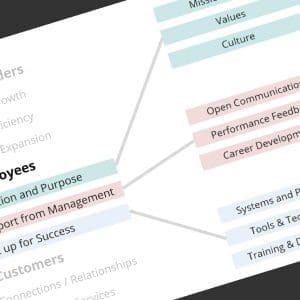To understand who should take a leadership role in defining and building an ecosystem of data for your products, understand the roles in the Value Chain.
In my previous post, I told the story of ThermoCo, UBrewCo, and their “IoT eco-system” of manufacturers, distributors, service providers, and customers. All of the players have a strong interest in the promise of operational data analytics, but none have the confidence and conviction to actually build something. Everyone seems to be waiting for the next person to make the move. And everyone has a solid reason why it makes sense for someone, anyone, other than themselves, to make that initial investment.
I’ve been drawn into a number of conversations about this dilemna, and three themes have consistently emerged …
It’s not the data …
The real value is in the analytics and the value-added services built upon the data that is collected. And for many years, data has been collected, cleaned, stored, and processed in a number of different places along these types of value chains. But the problem of what to do with the data has always been there; creative analysts, armed with snazzy visualization libraries, waiting for an impactful question for their engaging answers.
In fact, there is a new, more interesting debate brewing (aiw) around data ownership. I am seeing a strong preference for the basic assumption, made by the purchaser, that data generated by these Smart, Connected Products is theirs alone. The manufacturer may have rights to use this data for value-added services, but those telematics are tied to the metal that made them.
<aside> Data ownership gets interesting when your business model switches from selling to leasing equipment (addressing the job-to-be-done), but that’s an entirely different post … </aside>
Start at the Value
We’ve already discussed how value is created for all participants in the value chain – manufacturers, distribution, and end customer. But who stands to gain the most when we deliver detailed operational data?
- The component manufacturer (Thermoco) is after market share and vendor lock-in. Share growth is tough, because switching costs are high – but share gains generate predictable, healthy margins.
- The system manufacturer (UBrewCo) is looking for differentiation and market share, plus possibly service revenue – two different ways to grow the top line.
- The end customer (SipperCo) wants reduced downtime and higher availability of their manufacturing processes. They are not in the systems business, they are here to make beer – at high quality and lowest cost.
- The asset manager (WeFixCo) is all about leveraging resources across multiple plants. Over time, this could develop into a differentiated-level-of-service offering that competitors could not match – but in the short term they’re probably just looking to cut their costs.
So even though benefits accrue for everyone, the most impactful value seems to be with component and system manufacturers – the folks that make the equipment. Revenue growth can be more compelling than cost-cutting, especially when significant process change and/or infrastructure build is required. Many, therefore, look to the equipment manufacturers to make the leap; they are the ones that can add the sensors in the most economical manner.
One powerful tactic here would be partnering; component and system manufacturers working together to spec in sensors, data collection, and communications. R&D costs could be shared, spreading the risk a bit; the bigger conversations will be around technology sharing and exclusivity. Yes, a few more complications, but finding a way to co-develop these new capabilities could break the inertia and get things rolling.
It’s All About the Plumbing
Of course, one could argue that eventually, all participants in this value chain will get there in the end. Ubiquitous data availability, universal monitoring, and predictive maintenance down to the component level will be, at the end of the day, table stakes; everyone will have it, and true differentiation will be in the services provided.
So what is the value of being a first mover? Remember that underneath all is the data – and the APIs required to see it, move it, and share it. If your firm can take a significant part in defining the formats, standards, even the storage of the data in your particular market ecosystem, you can have a strong voice in the eventual definition of the industry standard.
The long-term value for anyone and everyone in the value chain is open access to the data; you won’t make money charging for data, you will survive and thrive only by leveraging that data. Especially in the early days, anything built that is “customer facing” (apps, services, web sites, etc.) and revenue-generating is temporary at best. It’s critical to focus on the use of the data, and the free-flow of data through the pipes between the members of the value chain.
If you really want to have a say in that, have any level of control over that conversation, best practice is to get involved early. And there’s nothing earlier than “first mover”.
What about Distribution?
Dealer / distributors are important parts of many industrial value chains, and they have a say here as well – they are typically data savvy, focused on smooth transactions at scale, and very interested in making things “sticky” between themselves and their customers. In addition, Dealers can clearly benefit from incremental volume plus the increased service and training demand that can come from a better informed end customer. Dealer / distributors can and should be looked at as the connecting glue that can broker, participate, even lead conversations around investment, technology, and implementation.
Next Steps
I am having a lot of fun working these issues in a number of industrial markets and niches – and every one has a unique story, and a different “best approach”. There is no one “best practice” for answering this question – just examples from other value chains, and imaginative conversation to find that riff that makes the most sense for your particular value chain.
I’ve got plenty of “beer conversations” stories to share … drop me a line and let’s talk!
12 June, 2016
- IoT Field Notes: How to Identify Customer Value
- IoT Field Notes: Building a Business Case
- IoT Field Notes: Size of the Prize
- IoT Field Notes: Whose Cloud is it Anyway? (part 1)
- IoT Field Notes: Whose Cloud is it Anyway? (part 2)
- IoT Field Notes: Who are you Disrupting?







This Post Has One Comment
Regarding the impasse of initiation: there’s a one liner regarding neighbors mowing lawns and where each other should stop mowing, “he who mows first picks.”
Somebody has to have the courage to get up and do something – even if it’s wrong. They should also be able to, with neighborly intent, keep the scope of their initiatives within what can be defensibly defined as a ‘property line’ within a couple blade-widths.
But data isn’t so darn easy as clipping grass, is it? And business isn’t as chummy as being neighbors (if you’ve got good ones).
I wonder if a fifth party is an option – but fear that their imposition would be rejected by one or more of the other four in the chain. Would it make sense to add a ‘as neutral as is realistic’ party that focuses only on actionable and relevant analytic output for each of the four other players? Would it be too disruptive to the status quo?